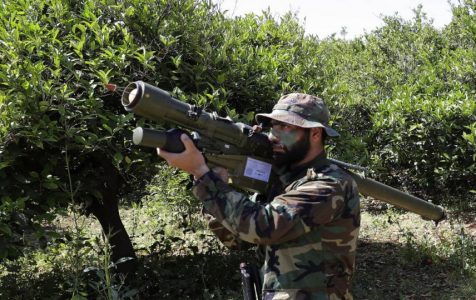
The dangerous new way Hezbollah is skirting American sanctions
Hezbollah is skirting American sanctions with a new and dangerous strategy.
According to an exclusive report the Kuwati news outlet Al Jarida, a senior official in Iran’s Islamic Revolutionary Guards Corp (IRGC) confirmed recent comments by Hezbollah chief Hassan Nasrallah, who declared that the terror organization is not manufacturing precision missiles in Lebanon.
However, that is only half the story. “It doesn’t mean that there are no [Hezbollah] factories manufacturing these missiles. It just means the group stopped manufacturing them in Lebanon a while ago,” the official said.
The official explained how Hezbollah has kept its regular missile factories in operation in Lebanon while moving the manufacture of precision heads and electronic parts to Syria.
Those parts are then discreetly shipped to Lebanon where they are put together.
This strategy avoids having to ship Iranian missiles from Syria to Lebanon. Such shipments, which are obvious and cumbersome, have become easy targets for Israel.
Hezbollah previously operated factories in Lebanon to build precision missiles, the official noted. After they were exposed, Hezbollah and, in turn, the Lebanese government were under enormous pressure from the U.S. due to the sanctions America put on Hezbollah.
Hezbollah, which controls a large part of the Lebanese government, needed to relieve that pressure to maintain its influence on the country.
“And, of, course, there was the fear that the locations of these factories would be revealed by spies for Israel,” he said. “So, Nasrallah wasn’t lying, because Hezbollah transferred those factories to areas in northeast Syria so they would be far away from Israel’s sights.”
The official revealed that Hezbollah imports the materials and machine parts it needs to build weapons factories from Bulgaria and Ukraine to Lebanon.
“The parts that are needed to turn regular missiles into prevision missiles are made in Iran, North Korea, China and Russia,” he said.
This new strategy has a number of implications for the U.S.
First, it shows that Iran’s proxy groups are becoming less and less dependent on Iran. As sanctions weaken Iran and as the regime faces a possible attack by the U.S., not only are their satellite terror groups becoming self-sufficient, they are potentially ready to come to the aid of Iran in such a scenario.
It is estimated that Hezbollah now has more than 250,000 short, medium and long-range rockets and missiles as well as the same precision drones that the Houthis, Iran’s proxies in Yemen, recently used to attack a strategic Saudi oil pipeline.
The IRGC official claimed that these drones can fly a distance of 850 km without being detected even by sophisticated American technology.
Iran and Hezbollah are both strapped for funds. In fact, last week the highly respected Saudi news outlet Al Arabiya reported that Hezbollah was pulling its fighters out of Syria because it could no longer afford to pay them.
Manufacturing precision missile parts in Syria and transferring them to existing missile factories in Lebanon saves the terror group precious funds and avoids the headache of alienating Hezbollah’s allies in the Lebanese government.
The U.S. needs to be aware of this situation and target Syria as well with sanctions to force them to close down Hezbollah’s operations in their country.
In addition, the U.S. needs to face the fact that Hezbollah is capable of using the same strategy to further their growing operations just south of the American border.
Source: Clarion Project





